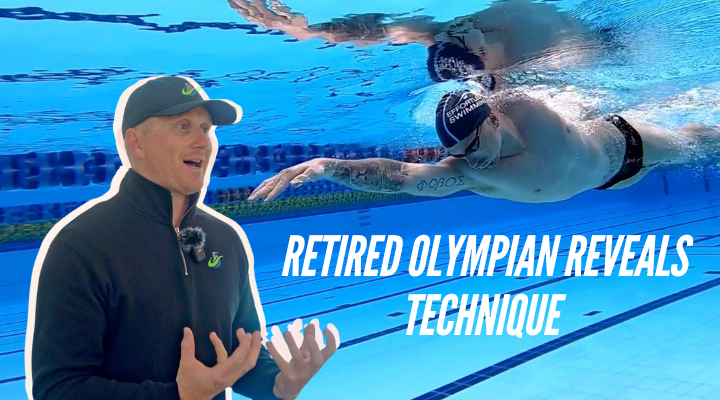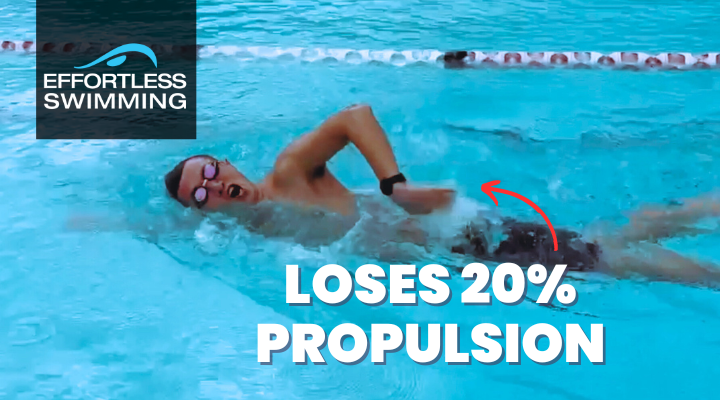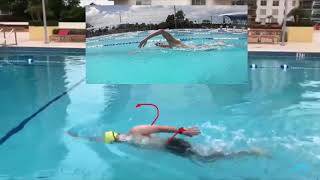There’s a big confusion around what a high elbow catch is, that it should be elbow near the surface. While it shouldn’t be really deep, the elbow will usually be at least 15 cm or more below the surface…but the way we define a ‘high elbow catch’ has got anything to do with its height.
Transcription:
Their elbow is at least 10 to 15 centimeters, even more, below the water there. If you’re thinking of high elbow catches, get the elbow up near the surface, that’s not necessarily the case there.
Hi, Brenton here. In today’s video, I’m going to talk about why the high elbow catch isn’t necessarily high. What do I mean by this? Well, there’s a lot of confusion around what’s a high elbow catch. The way it gets described or explained I think can make things very confusing.
The way that we tend to describe this inside our video membership and when we’re running clinics in campuses, your high elbow, the way we define it, is if you’re looking side on when you finish your catch which is in this position right here. If we draw a line from your shoulder to your fingertips, if your elbow’s above that line we consider that a high elbow catch. If your elbow is below that line, we consider that a dropped elbow catch.
Now, the biggest difference there is where’s the hand and forearm facing? With the dropped elbow catch you’re mostly going to be pressing down on the water. With a high elbow catch, you’re mostly going to be pressing back on the water and that is what is going to propel you forward. You’ve got a lot more surface area there that is pressing back behind you which is going to move you forward.
Whenever I talk about a high elbow catch, or a coach or someone else who’s talking about it, that’s what they’re referring to. Now, I have heard people talk about high elbow catches and get that elbow very close to the surface there but you don’t actually see that with a lot of the top swimmers, their elbow is at least 10 to 15 centimeters, even more, below the water there.
If you’re thinking of high elbow catches, get the elbow up near the surface, that’s not necessarily the case there. Especially with sprinters, you see them go actually pretty deep with their catch but most other swimmers, yeah, they’re going to be at least 15 centimeters or more below the surface of the water.
Now, a good way to approach the high elbow catch is think of your catch as the set-up phase. You’ve probably seen me talk about this on a number of videos, but the catch is basically from when you’re at full extension out in front, down to when your fingers finish pointing downwards there. Now, in that catch phase of the stroke, don’t go for power, don’t go for propulsion yet. All you want to do, your only goal, is to set yourself up in a high elbow position so that if we look from the side, that imaginary line, we want that elbow above it.
Now, when it comes to a high elbow catch, we work with a lot of adults sometimes not very mobile through the shoulders so trying to get anywhere in this extreme high elbow catch is just going to be pointless because physically it’s not a comfortable position for a lot of adults. In order to be able to sustain that position over time, especially over some of those longer distance swims, 2k, 4k, it’s not going to be sustainable to do.
What we normally recommend for most adults, especially if you’re tight and you’re not very mobile through the shoulders, is just go for anywhere in that high elbow range, even just slightly. If you’re trying to go for this Olympic level high elbow catch, it’s not going to be as effective as if you just get somewhere, just slightly in that high elbow range.
You actually see, with a lot of elite swimmers, many of them don’t get this extreme high elbow catch. Many of them are only just in that high elbow catch so there’s no reason to try and over-extend yourself in terms of your mobility and what is comfortable. Now, the caveat there is when you’re doing some of the drills, like the YMCA drill progression that you’ve probably seen, when you’re doing drills like that, or even the sculling drills, you may want to overdo and exaggerate the high elbow position in order for you to be able to learn and develop that sort of movement.
You’ll probably come back a little bit from that when you’re swimming but, when it comes to swimming, don’t try and go really extreme with it. It’s not going to be comfortable, you might even feel like your shoulders are getting a bit sore that way so just go for anywhere in that high elbow range.
Now, in terms of the four key positions that we like to achieve in the stroke, you’ve probably seen our video. I’ll put a link in the description of the four key positions for your catch and pull. When it comes to your high elbow catch, think of it as when you start your catch you’re out in front. Then all you really want to do there is just tip the fingertips down to the bottom of the pool without applying too much pressure and without really pulling your upper arm and your elbow back straightaway.
Have that little bit of time spent where the fingertips are just traveling down without really starting to pull back just yet. That is an easier way to get into a decent catch position. Then in terms of the third key position which is the power diamond, which is this position right here. Now, the reason it’s called the power diamond is if we look front on if we had both arms in that position it would look a little bit like a diamond shape. It’s kind of like half a diamond with that one arm there.
Now, the reason the best swimmers in the world get to that position is that number one, that’s when they can easily get into their lats there. We often see that the hand is a little bit wider than the shoulder in that power dime position. If we look side on, then you’ll typically get with most elite swimmers, shoulder, elbow, and hand, all aligned underneath the shoulder there. That’s the power dime position.
Whereas swimmers who aren’t really getting that catch very well, their hand tends to be too far out in front of them so the shoulder and elbow line up but the hand doesn’t. Now, in that power diamond position, a lot of people tend to go too deep and too straight with their arms there. I’m talking about most age group triathletes, most adults tend to go too deep and too straight there.
What we do, especially in those YMCA drills, is we get them to get your elbows out to the side, get your fingers pointing down, and get used to, get familiar with that position there under the body. Now, that’s not the catch phase of the stroke, it’s not really the high elbow catch, but it is the next phase, it’s the pull phase of the stroke.
Where a lot of people tend to get confused is they’re thinking about this high elbow catch where they’re either trying to have their elbow too far up, too close to the surface there and, again, it’s just not necessarily a comfortable position, doesn’t use the stronger muscles through the shoulders and the back there. With that power dime position, if you just think of having good posture, think chest out tall and proud, get the arms in that power dime position, that is really going to get you into your laps, into your stronger shoulder and back muscles. That gives you a lot of surface area that’s going to be pressing back there.
That’s why we go through these YMCA drills where you just have the time to be able to get familiar with those key positions. If you’re not currently in those key positions, then through that drill you’re just giving yourself the time to be able to make the adjustments there. It pays to just look at your hands and see what you’re doing with them and make the adjustments. If you can’t get a high elbow catch in, let’s say, the YMCA drill, very little chance you’ll be able to get it when you’re swimming.
That’s really the purpose of a lot of drills is we just want to be able to isolate a certain movement. We want to break down a certain movement or position, get it right in the drill. Then you’ve got a much better chance of getting it right within your swimming stroke. If you know that your catch isn’t where it needs to be, then a way that you might want to approach it is get a couple of drills that you know are going to help you develop a better catch position. If you don’t know what drills can do that, there’s a lot … Obviously, the YMCA drill is a really good one.
Even just a simple front sculling drill where you are keeping the elbows somewhat forwards and high there, or even the catch kick drill which we’ve shown a couple of months ago. Any of those drills can help you get a feel for and a sense of what it’s like to get into that position. If you know that your catch isn’t great, you might want to do some of those drills.
Now, with those drills, it probably pays to put a snorkel on and wear some fins. Now, the reason for that is wearing some fins will just take the pressure off, keeping the body position up. It’ll give you that forwards momentum. With the snorkel, it takes the breathing out of it so you can focus just on making sure that your arms get to the right position in the stroke there. A snorkel, if you don’t have one, go out and get one, it is one of the best tools that you can use for your swimming.
Now, when you are doing the drills, make sure that you’ve got the right position. Just look forward, make adjustments if you need to. Now, if you don’t know what the right positions are, we’ve covered a lot of videos and I’ll link to those four key positions that we want to have in the catch and the pull. I’ll link to that video below and go and check that one out because that will explain it really, really well.
Now, then once you go into your swimming … So you practiced those drills, your arms are in the right positions using the drills, then when you go into your swim stroke you don’t necessarily need to take the fins off and take the snorkel off straight away because that’s going to make it a little bit harder to be able to maintain that better technique in your swim stroke.
There’s nothing wrong with wearing a snorkel, even putting a pool buoy on, and just going through a couple of laps of easy swimming. Number one, that’ll take the kick in the body position out of it, you’ll sit up nicely. With a snorkel on, it’s going to take the breathing out of it and then you can focus, again, just on the catch and the pull and make sure that that is happening in the stroke there.
It can be good just to progress, build-up, and make it a little more challenging and a little more difficult to maintain those changes in your stroke. That’s what I often recommend, especially if you’ve got the time. If you’re not training with a squad every single session, if you have any sessions that you’re on your own, you can just take the time to do these things, then that can be a really good approach.
If you haven’t got fins or a snorkel, they’re two toys that are worth having in your kitbag, same with the pool buoy, that’s another good thing. Then you can just wear that pool buoy and focus on the catch and the pull a lot easier than if you’re having to kick, especially if you’re newer to the sport. If you’ve only been swimming for six months, 12 months, or even two years, then you might do a little bit of swimming with the pool buoy on and the snorkel in order to be able to make it easier to make those changes.
Now, know that when you take that gear off you’re not going to nail these positions. You’re not going to get them 100% right every single time. If that was the case then, not even Olympians do that. Just know that it’s not going to happen straight away and it’s not going to happen perfectly every single time. The more you practice it, the more you train, the more time you go through these drills, the more often you’ll be able to get it.
Don’t be annoyed with yourself that catch I didn’t get and I can feel myself slipping. You want to pick yourself up when you notice that you don’t do the right thing when you’re not in the right position, and then just try and do it on the next one. No, it’s not going to happen all the time because it takes a while and it really takes repetition to be able to develop these motor patterns. Allow yourself the time, have that long term approach, and don’t get annoyed with yourself if you, or when you feel that you’re not hitting those positions because, no, that’s all part of the process.
If you get frustrated with yourself, that only delays the progression, it only makes it take longer. Just laugh about it, even stop, take a reset, and go again and know that it’s not going to happen all the time. That’s the catch and the pull [inaudible 00:11:11], the full drill progression that we like to go through or the full YMCA drill progression, that’s inside our video membership.
Click the link below and go and visit that page. It’s only $55 a year, for now, it will be going up very shortly. It’s $55 a year, that’s got all of our courses, all of our workouts, and all of our five core principles to help you become a better swimmer. Plus, if you’re looking for drills or wanting to know exactly what you can do to develop a high elbow catch that’s sustainable, that you can hold over the course of 3.8k’s or longer, then that is the best place to go. That’s our video membership, it’s only 55 bucks a year.
Go and check that out, it’s in the link below. Thanks again for watching. Please like and subscribe if you haven’t yet, and I’m looking forward to seeing you next week with another video.









